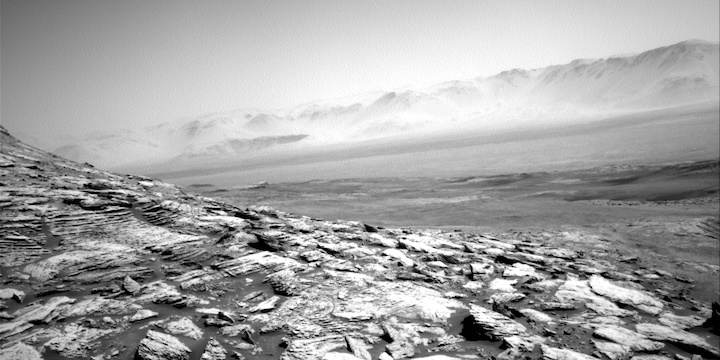12.11.2019
The Curiosity rover is looking for life on a bleak mountain in the middle of a crater, and it wants us all to feel its struggle.

A photo of Mars taken by the Curiosity rover shows a bleak landscape of hills and hazy crater mountains.
Mars is the only known planet in the universe inhabited solely by robots. There's InSight, the sturdy robo-stethoscope listening for the Red Planet's heartbeat; there's Odyssey and the gang, a cadre of droids surveilling the planet from orbit. And then, climbing a lonely crater hundreds of miles away from its companions, there's Curiosity, the last surviving rover on Mars.
About the size of an SUV and capable of traveling 100 feet (30 meters) per hour, Curiosity has been exploring the 3.5-billion-year-old pit called Gale Crater since landing there in 2012. Now, Curiosity is climbing the mountain, known as Mount Sharp or Aeolis Mons, at the crater's center. In a bleak and beautiful photo taken on the 2,573rd Martian day of Curiosity's mission (Nov. 1), the rover showed off the vast emptiness of this rocky domain.
In the new picture, posted to NASA's Mars mission website, a debris-strewn butte curves up toward the mountain's side while an enormous ridge of hazy rock looms in the background. That ridge is actually the rim of Gale Crater, fencing the rover in for about 50 miles (80 kilometers) in every direction.
The photo was taken from Curiosity's back, showing the bleak horizon that the rover leaves behind as it begins its slow ascent from Mount Sharp's base. It's a lonely scene, to be sure, but Curiosity is looking for new friends all the time; one of the rover's primary objectives is finding evidence that Mars could (or once did) support microbial life.
The rover hasn't stumbled upon any native Martians (yet), but it has found plenty of evidence of past water and traces of elements like hydrogen, oxygen, phosphorus and carbon — all considered "building blocks" of life. Hopefully, the crust of sediment lining Mount Sharp will reveal more clues about how and when ancient water once flowed through the crater. In the meantime, it's a fine place to stop and enjoy the scenery. As you can see, there's no shortage of it.
Quelle: SC
